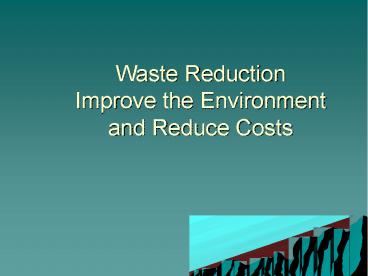Waste Reduction Improve the Environment and Reduce Costs - PowerPoint PPT Presentation
Title: Waste Reduction Improve the Environment and Reduce Costs
1
Waste ReductionImprove the Environment and
Reduce Costs
2
Climate Change Why worry?
- Climate relatively stable for the last 10,000
years - The average sea level around the UK is now about
10cm higher than it was in 1900.
Source Cox et al. 2000
3
Climate Change Thermohaline Circulation (THC)
- Heat from the equator is dispersed
- Stream turned off 13,000 years ago
Recent research indicates a 30 reduction in the
current
Source Hadley Centre
4
Climate Change Thermohaline Circulation
Source
Source Hadley Centre
5
Climate Change Why worry?
- 1.5 C could cause
- Greenland ice sheet 3 Million Km3
- 7m rise in sea levels
- 10,000 billions of metric tons of methane
hydrates to destabilise
Source Hadley Centre
6
Government action- Environmental impact
- Landfill waste reduction
- Product life cycle
- Emissions reduction
- Energy use reduction
7
Economic climate change
- Competition for energy
- Rising fuel prices
- Increased pressure to comply with legislation
- Increased need to cut overheads and production
costs
8
Reduce Waste
- Cost for manufacturers
- For every tonne of household waste produced,
commercial, industrial and construction
businesses produce another six tonnes - 5 million tonnes of hazardous waste in England
and Wales every year - Manufacturers could save around 1 of turnover
through simple, yet effective, techniques to
minimise waste - Source Defra
9
Increase Energy Efficiency
- SMEs are wasting as much as 30 of their energy,
equal to 1.1 billion or an average of 7,000 per
business
- Motors are the biggest energy wasters
- Use a variable speed drive
- A 50 reduction in speed 87.5 reduction in
energy consumption - This could mean payback time of less than one year
10
Increase Energy Efficiency
- Lighting
- Energy saving bulbs
- Turn unused lights off
- Heating
- Air conditioning can double your energy bills
- Buy energy efficient equipment and maintain it
- Compressors can often be wasting 30 in every
100 - Reduce use of materials, packaging
- Reduce transport costs by sourcing locally
11
Food Miles
- a term which refers to the distance food travels
from the time of its production until it reaches
the consumer or end-user. It is one dimension
used in assessing the environmental impact of
food. - is part of a broader issue of sustainability
which deals with a large range of issues,
including local food - the direct environmental, social and economic
costs of food transport are over 9 billion each
year
12
How Food Travels
- Recent findings indicate that it is not only how
far the food has traveled but how it has traveled
that is important to consider. - The positive environmental effects of specialist
organic farming may be offset by increased
transportation, unless it is produced by local
farms. - But even then the logistics and effects on other
local traffic may play a big role. - Also, many trips by personal cars to external
shopping centres would have a negative
environmental impact compared to a few truck
loads to neighborhood stores that can be easily
accessed by walking or cycling. - A locavore endeavors to eat food from within a
foodshed having a radius of 100 miles.
13
Criticism of food miles
- A comparison total energy used in food
production in Europe and New Zealand, taking into
account energy used to ship the food to Europe
for consumers. - New Zealand agriculture tends to apply less
fertilisers (which require large amounts of
energy to produce and cause significant CO2
emissions) - and animals are able to graze year round outside
eating grass instead of large quantities of
brought-in feed such as concentrates. - Dairy is twice as efficient,
- Sheepmeat four times as efficient
- Apples NZ is more energy efficient
14
Reduce transport costs by sourcing locally
- Food Miles
- Companies with under 100 tons of fruit per year
have an overall energy turnover of 1.1 to 2.5
kWh/litre while companies with more than 2,000
tons per year have less than 0.5 kWh/l. - Just in terms of transport and distribution,
small fruit companies need 0.5-0.8 kWh/l while
even though they are covering large distances,
the large companies use only 0.1-0.3 kWh/l.
15
Comparative shipping Cost
16
Unit Operations
17
Equipment
18
Continuous operations
- UHT
19
Concentration of Liquids
20
Refrigeration
- Reveres Cycle Heating
21
Fermentation of Waste
22
Case Study 1 - Advance Enterprises
- Resins
- Medium high density fibre board, plywood,
ceramic tiles - Formaldehyde
- Used in 85 of MDF production
- EU market 2 million tonnes
- Carcinogen
- Petroleum based
- Cost subject to variation
- Bad for environment
- Alternative to formaldehyde resin
- Styrene-acrylate co-polymer water based emulsions
23
Case Study 1 - Advance Enterprises
- Development of resin from sustainable source
- Opened up market in developing countries with
indigenous raw material - Rapeseed oil - Reduced waste to landfill from food industry
- Product with uses in
- Composite materials
- Fuel utilising short term carbon cycle from
sustainable materials
24
Case Study 2 Surgicraft
- Manufacturers of artificial ligaments
- Polyester or carbon fibres
- Gelatine coating
25
Case Study 2 Surgicraft
- Coatings problem
- Gelatine
- Linked with BSE CJD
26
Case Study 2 Surgicraft
- Needed to find solution
- Gelatine free
- Right properties
- Expertise in coatings and chemical detection of
substances - Solution Alginate
27
Case Study 2 Surgicraft
- New coating safe and biocompatible
- Eliminated need for process step
- Saved energy
- Saved time
- Reduced cost
- Safeguarded market of 190K per year
- Safeguarded jobs
- Safeguarded potential to sell the product in USA































